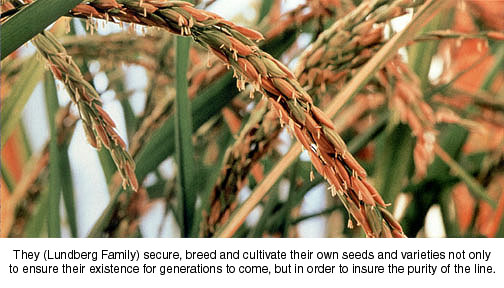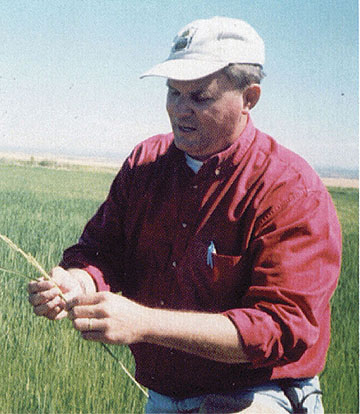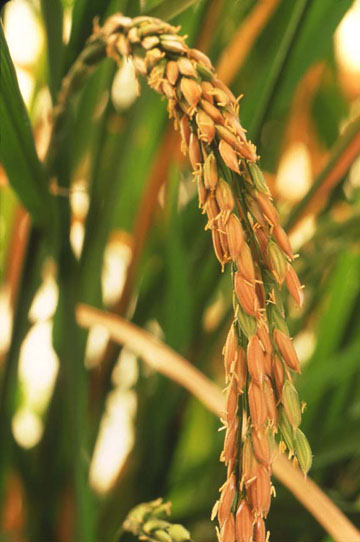Lundberg represents a growing sector of family farmers adapting to the demands of a specialty (higher quality) marketplace. The globalization of the food market allows for customers in foreign, as well as domestic markets, to custom grow rice with Lundberg that suits the tastes of the market.
If you sent all the rice grown in California for one year to Japan and replaced their existing supply, an annual California crop would be consumed in about 12 short weeks. Why then does Japan look to specialty rice farms, like Lundberg Family Farms, to supply them with organic rice? While the answer isn’t obvious at first, after spending a day in their rice fields, it became apparent.
On a beautiful, sunny day in Richvale, California (about 20 miles south of Chico) I accompanied Bryce Lundberg, a family farmer of the renown Lundberg family, on a tour of their 10,000 acre farm. I say this, because no day would be too beautiful if it was steaming hot, as it is often apt to be in the 100 degree plus days that are characteristic of this agricultural region. The weather’s been cooler than expected this summer, delaying the harvest season by about two weeks. I fully expected to see the wild rice harvest in progress, along with the long grain, medium grain, short grain, aromatic grain, and their colorful exotic grains. Unfortunately, I arrived just a couple of weeks before the harvest was to begin.
“The cool temperatures this summer pushed the harvest off for, oh, about a couple of weeks,” explained Bryce. He added, “We’re ready to go, the minute it’s ready to harvest.”
PURITY OF SEED LINES
Lundberg Family Farm grows about 13 different varieties of rice. Many varieties will remain whole grain brown rice while others are milled down to white rice. While all Lundberg Family Farms rice is grown using sustainable farming methods, each variety is also grown organically as well. New varieties are always under development in their nursery and in experimental plots. They develop, breed and harvest their own seed and varieties not only to ensure varietal survival (and supply) for generations to come, but also in order to ensure the purity of the varieties.
Bryce continued, “Many of the varieties we grow are not grown anymore by the California rice industry so we keep the varieties growing ourselves. We propagate our own seed. The varieties I’m showing you are currently in the seed development program at our farm. We sow large seed paddies and we develop the seed that we use for planting.”
As we drove by seed plots of Wehani, Arborio, California Basmati, California Jasmine, Black Japonica and many others, we came across a variety I had never heard of before. “What is Hong Kong Black?” I asked.
Bryce stopped the truck so we could get out to take a look. Hong Kong Black, I found, is another variety currently under experimentation on the Lundberg Farm. “This variety originates from Asia,” he explained. “We do a lot of crossing. We take a variety that is in our nursery and clip the seeds, collect the pollen, and do a manual cross. Then we take the pollen, swap the seeds, and grow them to see what kind of cross we get to accommodate for the climatic differences that otherwise would make growing the original variety unfeasible.”
The desire to create outstanding varieties of rice is an art form treasured by the Lundberg family. Only natural methods involving cross-pollination are used. “Here is a new variety of sweet rice,” Bryce indicated as he pointed to a small sized patch to our left. “It’s not new, it’s from Japan, but it’s a variety that our customer from Japan wants, so we are doing some experiments to see if it can grow here. This goes to a seed field next year, and it will be ready to be planted for crop the year after that. After this year, we will have a pretty good idea if it will come to fruition or not.”
Purity is the focus here, and purity is always the goal. Unless we produce a pure strain of seeds in advance, we’d end up with rice that may have desirable characteristics, but wouldn’t be pure. Seed operations often strive for purity, but what is truly unusual at Lundberg’s is that a crop-producing farm would set aside acreage to grow their own seed. “It’s because we produce so many varieties that are not grown commercially in California or anywhere, that we need to maintain these varieties for the future. Our small plots maintain our purity.”
WEED CONTROL STRATEGY FOR ORGANIC RICE
Organic farming represents about 60% of the acreage at Lundberg Family Farms. “While we do eradicate the weeds by flooding the paddy during the first phase, it does stress the rice. In our second phase we dry up the fields so that the remaining water hardy weeds are destroyed and hope the remaining rice is strong enough to thrive,” Bryce comments.
Weed control strategy is a buzz term on this farm. Organic farming results from a love for the environment and a desire to always use natural methods to maintain the delicate balance of nature. But with it comes an extra commitment to observation. The Lundberg’s keep a keen lookout to assure their current strategy maintains effectiveness. Weeds are capable of adapting to extreme environmental variances, so even though a natural weed control method works now, there are no guarantees as to the duration of time a particular method will remain effective ,so the Lundberg’s are always working on an innovative natural solution to replace those that aren’t doing the job. One method of stressing the weeds through flooding then subsequently drying up is quite effective. The word of their success practicing this method spread, and other organic farms are trying their hand at this technique as well. It’s challenging most of the time.
CROP CYCLE OF ORGANIC RICE
Early in the growing season, Lundberg Farms uses deep water to drown the grasses. Weed control is the number one challenge in growing organic rice. For every rice seed planted, there, are potentially 50 weed plants that could grow around it, choking it off. If you have a seedling at the beginning of the year and you put water over the top of the soil, grass and weeds start to grow at the same time. But weeds need to get through the water and get a leaf on top in about 20 days. Rice has a window of about 48 hours longer to get its leaf up. If it doesn’t, then the rice will drown as well. Different varieties have a tougher time surviving. Akitokamachi, for example is really challenging. Over time, total weed control is not possible. “We could anticipate over time, that the weeds will become more adaptive to whatever technique we are using, so we will devise another natural control method,” explained Bryce.
During the second phase, the fields are drained of all water for sedge control. This dry-up phase is another form of weed control to eradicate the weeds and the weaker rice. Water management is always a key issue involved in farming organic rice. During the third phase, water is let back into the fields, so the crop can reach final maturation.
Lundberg Family Farms base acreage is roughly 3,500 acres, and they manage another 7,500 acres through their loyal family of growers. As we drove through the farm, I commented often on the natural ruggedness and beauty of the terrain. On all the farmable land, they utilize crop rotation as part of their strategy to build and maintain healthy soil. Also, all acreage is routinely fallowed, that is, given a periodic rests from planting to restore soil to its optimum condition.
THE WILD RICE CROP
Nothing surpasses the beauty of a wild rice crop. If you’re inclined to marvel at nature’s creations, then you must include a stop to a wild rice field next August, just before the harvest begins. Standing over 12 feet high, the beautiful stalks of lavender, tan and golden plumes sway in the breeze to create a rippling effect with nature’s colors. As we got out of the truck to get a closer look, I chose to stay on terra firma, rather than schlock through the muck, because Bryce had the only hip-high wading boots necessary to walk through the fields. So dense was the field, the ground was not even visible. Bryce inspected the stalks of the rice to see if they were ready to harvest. The unexpected cool weather had slowed the maturation process down so harvest was going to be delayed.
AKITAKOMACHI
As we drove by the Akitakomachi, a Japanese variety, I was amazed to notice it sported an almost auburn hue. This paddy had just come out of the dry up cycle and the crop had not finished greening up. Akitakomachi is treasured for its beautiful round, pearl-like grain and delicate flavor. Typically milled to a white rice, Akitakomachi is favored for used in Pacific Rim dishes, sushi in particular. The Lundberg’s successfully grow and experiment with several varieties of rice originating from Asian countries, making them the primary choice for Pacific Riclients desiring their crops to be grown in California.
RICE CAKES
The popularity of Lundberg’s delicious rice cakes in Europe began with an American who relocated to Holland. After several months of buying and importing his personal supply of Lundberg rice cakes, this enterprising fellow became a European Lundberg broker. He assumed if Europeans loved Lundberg’s rice cakes as much as he did, a great market potential could be realized. As a result of this vision, Lundberg Family Farms is enjoying an eager and growing market throughout Europe.
Lundberg rice cakes are different than typical European rice cakes. Now that the European markets tasted the thicker, crunchier, denser, tastier cake, they really like them! Repeat business is steadily increasing. “In the U.S. markets, most of the rice cakes are about the same size, but ours have twice as much rice in each cake,” VP sales and marketing Tim O’Donnell explains. While it hard to note the difference between Lundberg rice cakes and conventional rice cakes while they are in the package, Lundberg’s are “deliciously dense”. In the Euro market, traditional rice cakes are even smaller, thinner, and even less crunchy. Basically there is nothing like our rice cake in any other country. ”
The Lundberg rice cake package weighs about twice as much per package as other American brands, with an even bigger difference in the European brands. Repeat business stems from a crunchier, tastier, more nutritious rice cake. Lundberg rice cakes can even be very lightly toasted, an advantage that they maintain over all available other brands. “The ability to toast the cake is clearly an advantage,” O Donnell explains with a smile. ” The fragrance is similar to baking bread.”
The Lundberg rice cake recipe is proprietary, of course. In the rice cake popping facility, located at farm headquarters, they have custom-designed and continuously improved their innovative system of popping delicious rice cakes, and they add a delightfully diverse range of all natural toppings and flavors to their 18 different flavors. Representing a large percentage of the Lundberg’s business, rice cakes have been a favorite with their loyal American consumers for many, many years.
“Customers want to know that they are eating a pure and healthy product. If you start out with a great grain, you are going to end up with a great rice cake. We will continue to support this product into the European markets.”
[nggallery id=1]
















